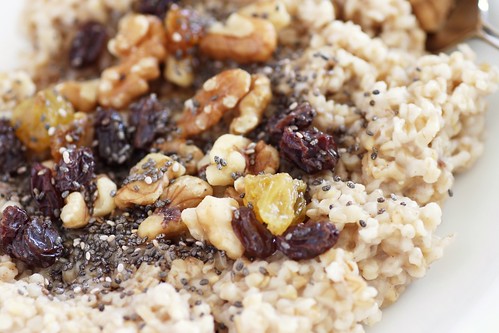
When I found out I was pregnant, I promised myself that I wasn’t going to be That Mom who overshares about bodily fluids on social media. Now that I have a 6-month-old (whaaaat?) I realize that dealing with bodily fluids occupies much of my day. I’m doing pretty well on social media.
But I never said I wouldn’t blog about bodily fluids! Indirectly, since this is really about digestion before anything exits your system. Ahem.
Is it glamorous? No. But what goes in must come out, and I’ve had several clients with questions about this topic. So here goes!
Fiber is good stuff. It’s not nutritious (in fact, babies starting solids shouldn’t have too much because it can clog their developing digestive tracts), but adults need fiber to help our systems work. When people switch from refined (white) to whole grains and increase their produce intake, they’ll often notice the impact of all that fiber.
Some people, however, can have uncomfortable side effects from a high fiber diet. The main reason is that they’ve increased one type of fiber more than the other.
Soluble Fiber
Soluble fiber dissolves in water, forming a gel which slows down digestion. It helps you feel full longer, prevents spikes and drops in blood sugar, and can lower cholesterol. It creates volume in your digestive tract.
Good sources of soluble fiber: oatmeal, lentils, black beans, kidney beans, navy beans apples, apricots, oranges, grapefruit, pears, oat bran, strawberries, nuts, flax seeds, peas, blueberries, psyllium, Brussels sprouts, cucumbers, celery, turnips, and carrots.
Insoluble Fiber
Insoluble fiber does not dissolve in water and passes through the digestive tract mostly intact. This speeds up movement in your digestive system.
Good sources of insoluble fiber: whole wheat, whole grains, wheat bran, corn, seeds, nuts, barley, couscous, brown rice, bulgur, zucchini, celery, broccoli, cabbage, onions, tomatoes, carrots, cucumbers, green beans, dark leafy vegetables, dried fruit, grapes, fruit, and root vegetable skins.
Digestive Dilemmas
If you feel bloated and/or constipated, you need more insoluble fiber for movement. If you have diarrhea, you need more soluble fiber for bulk. You need both for regularity.
Over 70% of your immune system is located in your gut. If your digestive health isn’t good, your general health will suffer. It’s not normal to have chronic digestive problems. Try adjusting your fiber intake first, but if problems persist, you could have a food intolerance or an inflammatory condition.
Here’s to healthy, happy, high-fiber diets!
Any other questions? Don’t worry, I won’t fish for digestive stories.


